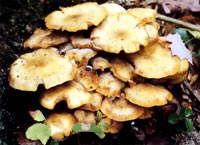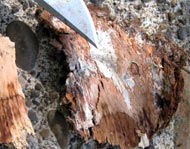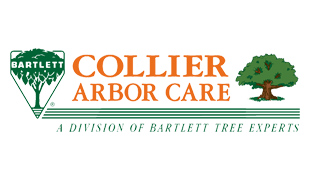|

Honey colored filled mushrooms may appear in late autumn during rainy periods. Armillaria Root RotDownload a PDF of this articleDescriptionArmillaria root rot is caused by a soil borne fungus. Common names for the disease are the shoe string and the oak root fungus. This refers to the black shoestrings of the disease called rhizomorphs that survive during unfavorable conditions. There are several distinct species of the fungus. It is found world wide but it very common in the heavy clay soils and cool climate of the Northwest. Plants AffectedArmillaria root rot attacks over 700 species of plants most of which are woody plants. Among the shade and ornamental trees, oaks and maples are the ones commonly infected. Other tree hosts include, beeches, birches, dogwoods, Douglas fir, elms, hemlocks, poplars, and rhododendron, willows and fruit trees. Symptoms/DamageAbove ground symptoms include; premature fall coloration, stunting and poor growth, and general health decline of the plant, twig and branch dieback. Such a decline usually occurs over a several year period but may appear to progress quickly during advanced infection. Death of the tree quickly follows. Often trees infected with Armillaria will blow over in wind storms showing an abnormally small root ball with stubbed off, decayed roots. On infected conifer trees such as Douglas fir a resin or pitch flow exudes from the lower trunk. Positive signs of the fungus are found at the base of the trunk (root collar) or in the main roots. White, creamy, paper thick fan shaped sheets of fungus strands (mycelium) can be seen growing over sapwood when the bark is removed for inspection. Also present under the bark or in the soil around the root collar are the black root like shoe strings or rhizomorphs. These cord-like structures grow out from infected roots into the soil and can spread infection to other trees. Small clusters of yellowish or honey colored gilled mushrooms may appear in late autumn during rainy periods. Life CycleArmillaria survive as rhizomorphs or mycelium in dead or dying wood in stumps or roots and in the soil for decades. The fungus can spread by root to root contact from infected plant parts or by contact with the rhizomorphs. Also the fungus can be spread by air borne spores released by the mushrooms to dead stumps or injured bark. Trees that are stressed by drought, insect attack, or other disease are more susceptible to attack. Also trees that have had soil fill over their root systems or an installation of lawn and excessive irrigation in the drip zone of the tree can also trigger infection. Many native oak and other tree species are commonly infected and die from this drastic change in root environment. ManagementOften it takes an expert to accurately diagnose Armillaria. We use a technique of exposing the root crown with a tool called an Air-Spade® to allow for diagnosis of the root rot or other root problems. CulturalDon't plant susceptible tree species in areas where trees have died from Armillaria. Resistant tree species include: ginko, magnolia, sweet gum, dawn redwood and incense cedar. Remove and dispose of infected stumps and roots if practical. Do not stress or change the root environment around existing trees. Avoid fill soil (raising grades) over root systems, and do not over irrigate. Water trees moderately during extended drought conditions to prevent stress. Partially infected trees with only a small percentage of roots or root collar infected can have the root collar excavated to expose to air and drying to stop the spread of the disease. ChemicalThere is no known chemical control of Armillaria root rot. |

White, creamy, paper thick fan shaped sheets of fungus strands (mycelium) can be seen growing over sapwood when the bark is removed. |
|
Home |
Services |
The Arbor Advisor |
Garden Calendar |
About Us |
Fact Sheets |
Contact Us |
Site Map Collier Arbor Care Portland 503-722-7267 Vancouver (360) 693-6056 Site contents and design ©2013 Collier Arbor Care |





